Eichstaettisaurus
| Eichstaettisaurus Temporal range:
| |
|---|---|

| |
| Type and only specimen of E. schroederi | |
| Scientific classification | |
| Domain: | Eukaryota |
| Kingdom: | Animalia |
| Phylum: | Chordata |
| Class: | Reptilia |
| Order: | Squamata |
| Family: | †Eichstaettisauridae |
| Genus: | †Eichstaettisaurus Kuhn, 1958 |
| Type species | |
| †Eichstaettisaurus schroederi (Broili, 1938)
| |
| Other species | |
| |
| Synonyms | |
|
E. schroederi
| |
Eichstaettisaurus (meaning "Eichstätt lizard") is a
Initially named as a species of the genus
Discovery and naming
E. schroederi
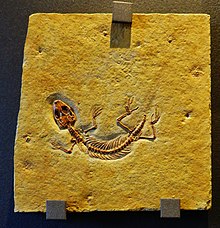
In 1938, Ferdinand Broili described an exquisitely-preserved specimen of lizard, preserved top-side-up, from Jurassic-aged rock deposits in the municipality of Wintershof, Eichstätt, Germany. The specimen came into the possession of the Bavarian State Collection of Paleontology and Historical Geology (BSPG), where it was prepared by L. Haimerl. It consists of a nearly-complete skeleton, albeit with a crushed skull, a tail missing the tail after the fifth vertebra (probably the result of amputation and replacement by cartilage), and several vertebrae preserved only as impressions (but their presence could still be verified by the associated ribs). A counterslab to the specimen also exists.[1] Today, the rock deposits are known to belong to the Altmühltal Formation, and the specimen and its counterslab are stored under the accession numbers BSPG 1937 I 1a and 1b.[2]
Although he was unable to examine it first-hand, Broili noted from Christian Erich Hermann von Meyer's description of the type specimen of Ardeosaurus brevipes that it bore similarities to this specimen, but also that they had important differences in snout and frontal bone shape, as well as vertebral counts. However, he hesitated to create a new genus due to the preservational state of the skull. Thus, he assigned it to the genus Ardeosaurus with reservations as a new species, A.? schröderi, named after his colleague J. Schröder.[1] (The current specific name is schroederi: by Article 32.5.2.1 of the International Code of Zoological Nomenclature, umlauts in German names published before 1985 must be deleted and be replaced with an "e" inserted as the next letter.)[3]
Contrary to Cocude-Michel, Hoffstetter identified digitatellus as a member of Ardeosaurus separate from Eichstaettisaurus in 1964. Even though Cocude-Michel was aware of Hoffstetter's paper, in 1965 she reiterated her argument and made no attempt to address Hoffstetter. Hoffstetter responded in 1966, calling Cocude-Michel's synonymy "unbearable". He noted that it would entail the revision of the
E. gouldi

For many years, Eichstaettisaurus was known from the single specimen of E. schroederi until Cretaceous-aged remains were found elsewhere in Europe. In 2000, Susan Evans and colleagues described a small lizard specimen in the Berriasian–Valanginian aged locality of Montsec in Catalonia, Spain. Despite its poor preservation, the specimen was clearly distinct from the more common lizard in the locality, Meyasaurus; Evans and colleagues suggested that it held affinities to Eichstaettisaurus.[7]
In 2004, Evans and colleagues reported even younger remains of Eichstaettisaurus, which originated from the
Description
Eichstaettisaurus was a relatively small animal. E. schroederi had a snout-vent length (measured from the tip of the snout to the opening of the cloaca) of 94 mm (3.7 in),[2] while E. gouldi had a snout-vent length of 56 mm (2.2 in).[4]
Skull
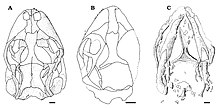
Eichstaettisaurus can be identified by flattened skulls with short, blunt, and rounded snouts. E. schroederi had large nostrils. The tooth-bearing bones of the snout, the
Unlike A. brevipes, E. schroederi lacked bone ornamentation and osteoderms on the skull roof. In both species, the frontal bones were fused and narrower between the eye sockets than they were at the front. The downward projections on the frontals known as subolfactory processes were well-developed in both species, but met at the midline only in E. schroederi. The suture between the frontal and parietal bones was convex in E. schroederi and concave in E. gouldi, unlike Ardeosaurus where it was straight. E. gouldi and most other lizards have fused parietal bones, but they were paired and unfused in E. schroederi. The parietals of both species lacked rearward projections and nuchal fossae. In E. schroederi, the outer edges of the parietals curved inwards, and the rearward projections known as the supratemporal processes were short, widely separated, and bore depressions. Also in E. schroederi, a pair of crests were present on the supraoccipital bone of the braincase, which were likely imprinted by the semicircular canals due to the skull's reduced ossification.[2][4]
Vertebrae and ribs
Compared to most iguanian,
Limbs and limb girdles

Eichstaettisaurus had a well-developed
In the
Classification
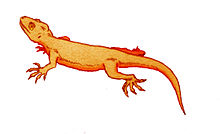
The
Upon separating schroederi into the genus Broilisaurus, Hoffstetter retained it within the Xantusiidae in 1953, but he noticed that its skull curiously resembled those of geckoes. Since xantusiids and geckoes were then placed on the two major recognized branches of lizards, Autarchoglossa and
However,
Subsequent phylogenetic analyses from Evans and colleagues found a variety of conflicting positions for Eichstaettisaurus and Ardeosaurus. In 2005, Evans and Yuan Wang conducted two analyses, one based on a 1998 analysis by Michael Lee and the other based on Evans and Chure's 1998 analysis, but they added
A 2006 phylogenetic analysis by Jack Conrad and Mark Norell likewise found Eichstaettisaurus as close to the Scleroglossa.[17] In 2008, Conrad published a large phylogenetic analysis of squamates including 222 taxa and 363 characteristics, which attempted to address the problem of incomplete taxon sampling (i.e. an insufficient number of included taxa) causing phylogenetic instability. To include Eichstaettisaurus, he combined data from E. schroederi and E. gouldi. He found that both Eichstaettisaurus and Ardeosaurus, along with Bavarisaurus, were part of the stem group of Scleroglossa. Along with the crown group of Scleroglossa, they comprised the Scincogekkonomorpha.[18] Arnau Bolet and Evans conducted two analyses based on Conrad's analysis, for the 2010 and 2012 descriptions of Pedrerasaurus and Jucaraseps, and recovered similar positions for Eichstaettisaurus. However, the former contained a polytomy since the relationship between Iguania, Pedrerasaurus, a group containing Ardeosaurus, Yabeinosaurus, and Sakurasaurus, and all other squamates could not be resolved.[19][20]
Jacques Gauthier and colleagues published another large phylogenetic analysis in 2012, containing 192 taxa and 976 characteristics. Like Conrad, they also combined data from E. schroederi and E. gouldi. They recovered a more derived position for Eichstaettisaurus as part of the stem group of Gekkota, along with the unnamed specimen AMNH FR 21444; in particular, they noted that its limb proportions strongly resembled gekkotans.[8] After adding Ardeosaurus digitatellus and re-coding Eichstaettisaurus to only include data from E. schroederi, Simões and colleagues found E. schroederi in a similar position, albeit in a polytomy with A. digitatellus and AMNH FR 21444. They identified a number of gekkotan traits: the paired parietals; the closed Meckelian groove on the lower jaw; the small, conical maxillary teeth; the short, blunt snout and flattened skull; the ectopterygoids overlapping the pterygoids; the two pterygoids and palatine bones being widely separated; the wide suture dividing the pterygoids and palatines from each other; and the lumbar-like vertebrae.[2]
In 2018, Mateusz Tałanda added Ardeosaurus brevipes to Gauthier and colleagues' analysis (but did not include the revisions of Simões and colleagues). He found Eichstaettisaurus in the same location alongside Norellius, but also recovered A. brevipes as a scincomorph closely related to skinks (in contrast to the stem-gekkotan position of A. digitatellus). Despite their different phylogenetic positions, Tałanda observed that the two species only differ by the widths of their parietals. He speculated that incomplete data due to the poor preservation of A. digitatellus could have influenced these results, and thus he retained it in the genus Ardeosaurus.[21] Another analysis conducted by Simões, Tałanda, and colleagues in 2018, this time using the revised data of Simões and colleagues, found a similar position for E. schroederi but a more basal one for A. brevipes in the Autarchoglossa.[22] In 2019, Vladimir Alifanov considered both Eichstaettisaurus and Ardeosaurus as scincomorphs closely related to Carusia but not to Xenosauridae, but did not perform a phylogenetic analysis.[23]
Below, phylogenetic trees from the two major phylogenetic analyses including Eichstaettisaurus are shown: one based on that of Conrad (Bolet & Evans, 2012, with relationships within Scleroglossa from Conrad, 2008),[18][20] and one based on that of Gauthier and colleagues (Simões and colleagues, 2018).[22]
Topology A: Bolet & Evans (2012) with Scleroglossa from Conrad (2008)[18][20]
| Squamata |
| |||||||||||||||||||||||||||||||||||||||||||||||||||||||||||||||||||||||||||||||||||||||||||||||||||||||||||||||
Topology B: Simões et al. (2018)[22]
| Squamata |
| ||||||||||||||||||||||||||||||||||||||||||||||||||||||||||||||||||
Paleobiology

Modern geckoes are unusual among lizards in that the digits of their limbs are relatively symmetrical in length, and are splayed in a broad arc; by contrast, the digits in other lizards are usually nearly parallel to each other, especially on the feet. The pattern seen in geckoes facilitates gripping while the body is in various orientations, since it spreads out the adhesive setae (bristles) on their toepads while allowing the first and last digits to oppose each other.[24][25] Eichstaettisaurus schroederi exhibited two characteristics that contributed to foot symmetry: its first metatarsal was long relative to its third metatarsal (with the third metatarsal only being 1.41 times as long as the first, as opposed to 2 times in a typical lizard), and its fourth metatarsal was relatively short. In 2017, Simões and colleagues observed that E. schroederi had stronger foot symmetry than Ardeosaurus digitatellus, and they inferred that the feet of both were likely directed further forwards than other lizards. This was also supported by the lack of bicondylar articulations in the phalanges, which are an adaptation for outwards-facing feet that resists displacement in the horizontal plane while enabling flexion in the vertical plane.[2]
Simões and colleagues also identified several other characteristics in E. schroederi, which suggest that the scansorial (climbing-based) lifestyles of modern geckoes arose earlier than previously appreciated. Its tall claws and elongate second-from-tip phalanges on the digits are both traits that have been strongly correlated with scansorial lifestyles in lizards.[26][27][28][29][30] In particular, the tall claws may have provided longer lever arms for the flexor tendons that retracts them, thus improving their gripping strength.[31] Meanwhile, its relatively short limbs and flattened body may have improved climbing performance by lowering its centre of gravity, as has been suggested for the Tokay gecko,[31] but this feature may not be correlated with scansorial lifestyles.[32] Finally, its limbs of similar lengths may have improved grip as in the sharp-snouted rock lizard; the significance of this trait may be diminished given the adhesive toepads of geckoes, and the lack of correlation between limb length ratio and scansoriality in the Lacertidae.[2][32]
In 2004, Evans and colleagues had also discussed the lifestyle of E. gouldi in light of its bodily proportions. They pointed to a previous study on how variation between proportions among species of snow skinks (Carinascincus) was correlated with habitat usage: short torsos and long hindlimbs were correlated with rock climbing (in large species) and tree climbing (in small species), while long torsos and shorter hindlimbs were correlated with ground dwelling.[33] Evans and colleagues found that E. gouldi was closest to the ground-dwelling species, which have slow running speeds and are relatively poor climbers, in its proportions. Nevertheless, they recognized that the flat bodies and tall claws of E. gouldi were adapted for clinging to rough surfaces. They proposed a hybrid lifestyle for E. gouldi: a slow-moving ground lizard with some capacity for climbing on rocks and hiding in crevices from predators like rhynchocephalians.[4]
Paleoecology
E. schroederi

The rock units at Wintershof that produced the only known specimen of E. schroederi are part of the
During the Tithonian, the plattenkalk of the Altmühltal Formation was deposited in oceanic basins (called "wannen") within a warm, shallow sea surrounding an archipelago.[39] These basins, which may have been lagoons, had a palaeolatitude of approximately 34° N, and were located at the northern margin of the Tethys Ocean. Fossils of bottom-dwelling animals like brittle stars and gastropods are virtually absent, which suggests that conditions at the sea floor were inhospitable to life; this may have been caused by one of several factors including hypersalinity, oxygen depletion, or the accumulation of toxic hydrogen sulfide.[38][40] These conditions were responsible for the exceptional preservation of fossils like that of E. schroederi,[41] which would have been predominantly transported from the surrounding land during heavy rainfall and storms.[42] On land, the absence of ferns and the dominance of dry-adapted conifers suggest that the climate was semi-arid.[43]
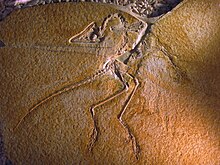
Both Ardeosaurus brevipes and A. digitatellus were discovered at Wintershof with E. schroederi,[2] along with Homoeosaurus maximiliani and the rhynchocephalian Pleurosaurus goldfussi.[5] Also known from Wintershof are the pterosaur Rhamphorhynchus muensteri,[44] the crocodyliform Alligatorellus bavaricus,[45] and various aquatic animals: the fish Anaethalion angustus,[46] Ascalabos voithii,[47] Aspidorhynchus acutirostris,[48] Belonostomus spyraenoides,[49] Caturus giganteus,[50] Gyrodus circularis,[51] Macrosemius rostratus, Palaeomacrosemius thiollieri,[52] Propterus elongatus,[53] and Zandtfuro tischlingeri;[54] the angelshark Pseudorhina alifera;[55] the squid-like coleoids Acanthoteuthis problematica,[56] Belemnotheutis mayri,[57] and Plesioteuthis prisca;[58] the crinoid Saccocoma tenella, which is very common in Solnhofen deposits;[59] the shrimp Dusa reschi;[60] and the horseshoe crab Mesolimulus walchi.[61] Nearby quarries have produced the Eichstätt specimen of the avialan dinosaur Archaeopteryx lithographica,[62] and the pterosaurs Aerodactylus scolopaciceps, Germanodactylus cristatus, and possibly Cycnorhamphus.[63]
E. gouldi
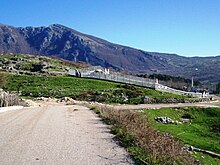
The Pietraroja or Pietraroia locality, from where E. gouldi specimens are known, is formed by a plattenkalk outcrop at the top of a
On the basis of foraminiferans, the Pietaroia locality has been dated to the Albian epoch of the Early Cretaceous. During this time, the plattenkalk of Pietraroia would have been laid down in a shallow water carbonate platform close to a small island. The depositional environment was originally thought to have been a lagoon,[65] but it has been re-interpreted as an east-flowing underwater channel that was gradually filled during the Aptian, based on patterns in the arrangement of fossils, the water currents, and the transportation of sediments. The lack of bioturbation likewise points to an anoxic environment, possibly related to a global oceanic anoxic event. Some fossils are well preserved while others were nearly destroyed, suggesting that they originated from various locations, with terrestrial animals like E. gouldi being brought into the channel by freshwater flows.[4][64] The climate would have been tropical to subtropical.[65]

In addition to E. gouldi and the rhynchocephalian MPN A01/82, other
References
- ^ a b c Broili, F. (1938). "Ein neuer fund von ?Ardeosaurus H. von Meyer" [A new find of ?Ardeosaurus H. von Meyer] (PDF). Sitzungsberichte der Mathematisch-Naturwissenschaftlichen Abteilung der Bayerischen Akademie der Wissenschaften zu München: 97–114.
- ^ .
- S2CID 196603846.
- ^ a b c d e f g h i j k l m n o p q Evans, S.E.; Raia, P.; Barbera, C. (2004). "New lizards and rhynchocephalians from the Lower Cretaceous of southern Italy" (PDF). Acta Palaeontologica Polonica. 49 (3): 393–408.
- ^ a b c d Cocude−Michel, M. (1963). "Les rhynchocéphales et les sauriens des calcaires lithographiques (Jurassique supérieur) d'Europe occidentale" [Rhynchocephalians and saurians from lithographic limestones (Upper Jurassic) of western Europe]. Nouvelles Archives de la Muséum d'Histoire Naturelle de Lyon. 7: 143–185.
- ^ .
- .
- ^ S2CID 86355757.
- .
- ^ Nopcsa, F. (1908). "Zur Kenntnis der fossilen Eidechsen" [To the knowledge of fossil lizards]. Beiträge zur Paläontologie und Geologie Österreich-Ungarns und des Orients. 21: 33–62.
- hdl:2246/898.
- .
- .
- ^ Evans, S.E.; Barbadillo, L.J. (1999). "An short-limbed lizard from the Lower Cretaceous of Spain". Special Papers in Palaeontology. 60: 73–85.
- ^ Evans, S.E.; Wang, Y. (2005). "The Early Cretaceous lizard Dalinghosaurus from China" (PDF). Acta Palaeontologica Polonica. 50: 725–742.
- S2CID 86410052.
- hdl:2246/5877.
- ^ S2CID 85271610.
- .
- ^ S2CID 83645014.
- S2CID 134878128.
- ^ S2CID 44108416.
- S2CID 181824832.
- doi:10.1139/z86-144.
- .
- S2CID 62782034.
- PMID 19632100.
- PMID 25069967.
- PMID 24151335.
- S2CID 24395310.
- ^ .
- ^ a b Vanhooydonck, B.; Van Damme, R. (1999). "Evolutionary relationships between body shape and habitat use in lacertid lizards" (PDF). Evolutionary Ecology Research. 1: 785–805.
- .
- .
- .
- PMID 31084702.
- S2CID 135104883.
- ^ S2CID 129127346.
- ^ S2CID 213606153.
- .
- .
- S2CID 33984022.
- S2CID 85327790.
- .
- hdl:10044/1/29026.
- ^ Ebert, M. (2012). "Crustaceans as prey in fishes of the Solnhofen Archipelago". Archaeopteryx. 30: 1–4.
- .
- ^ Ebert, M.; Kölbl-Ebert, M. (2010). "Morphology of the leading edges of the caudal and other unpaired fins in the Late Jurassic Aspidorhynchidae and some other actinopterygian fish in light of their function". Archaeopteryx. 28: 1–22.
- ^ Ebert, M. (2014). "The genus Belonostomus Agassiz, 1834 (Neopterygii, Aspidorhynchiformes) in the late Jurassic of the Solnhofen Archipelago, with a focus on Belonostomus kochii Münster, 1836 from Ettling (Germany)". Archaeopteryx. 32: 15–43.
- .
- ^ Kriwet, J.; Schmitz, L. (2005). "New insight into the distribution and palaeobiology of the pycnodont fish Gyrodus". Acta Palaeontologica Polonica. 50 (1).
- S2CID 88649682.
- ^ Ebert, M. (2012). "Histionotus (Actinopterygii, Macrosemiidae) – Eine Gattung mit vielen Fragezeichen" [Histionotus (Actinopterygii, Macrosemiidae) — a genus with many question marks]. Archaeopteryx. 30: 5–15.
- S2CID 181452064.
- ^ Thies, D.; Leidner, A. (2011). "Sharks and guitarfishes (Elasmobranchii) from the Late Jurassic of Europe" (PDF). Palaeodiversity. 4: 63–184.
- .
- ^ Engeser, T.; Reitner, J. (1992). "Ein neues Exemplar von Belemnoteuthis mayri Engeser & Reitner, 1981 (Coleoidea, Cephalopoda) aus dem Solnhofener Plattenkalk (Untertithonium) von Wintershof, Bayern" [A new example of Belemnoteuthis mayri Engeser & Reitner, 1981 (Coleoidea, Cephalopoda) from the Solnhofen limestone (Lower Tithonian) from Wintershof, Bavaria] (PDF). Archaeopteryx. 10: 13–17.
- S2CID 83370427.
- S2CID 85358369.
- .
- S2CID 55610538.
- ^ Göhlich, U.B. (2017). "Catalogue of the fossil bird holdings of the Bavarian State Collection of Palaeontology and Geology in Munich" (PDF). Zitteliana. 89: 331–349.
- S2CID 219204038.
- ^ S2CID 129309028.
- ^ a b c Bravi, S.; Garassino, A (1998). "New biostratographic and palaeoecologic observations on the "Plattenkalk" of the lower Cretaceous (Albian) of Pietraroia (Benevento, S−Italy) and its decapod crustaceans assemblage". Atti Societá Italiana Scienze Naturali, Milano. 138: 119–171.
- .
- .
- S2CID 4325093.
- .
- S2CID 4279738.
- ^ Taverne, L.; Capasso, L.; Del Re, M. (2020). "Osteology and phylogenetic relationships of Gregoriopycnodus bassanii gen. nov., a pycnodont fish (Pycnodontidae) from the marine Albian (Lower Cretaceous) of Pietraroja (southern Italy)" (PDF). Geo Eco Trop. 44 (1): 161–174.
- ^ a b Dalla Vecchia, F.; Barbera, C.; Bizzarini, F.; Bravi, S.; Delfino, M.; Giusberti, L.; Guidotti, G.; Mietto, P.; Palazzoni, C.; Roghi, G.; Signore, M.; Simone, O. (2005). "Il Cretaceo Marino" [The Marine Cretaceous]. In Bonfiglio, L. (ed.). Paleontologia dei Vertebrati in Italia: Evoluzione Biologica, Significato Ambientale e Paleogeografico [Vertebrate Paleontology in Italy: Biological Evolution, Environmental and Paleogeographic Significance]. Sezione Scienze della Terra. Vol. 6. Memorie del Museo Civico di Storia Naturale di Verona. pp. 101–112.
- .
- S2CID 52025491.
- .
- .
